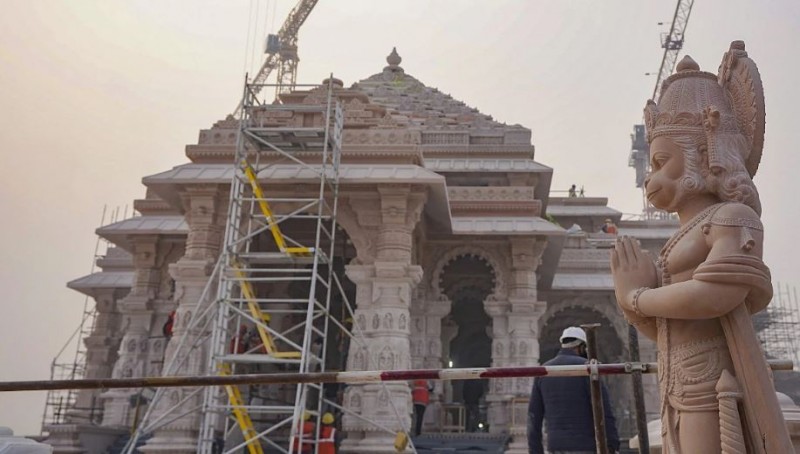
The construction of the grand and divine Ram Temple in Ayodhya has started taking shape, captivating everyone with its interior design. The ground floor of the temple is almost complete, with the total height of the temple expected to be three floors, and the construction of the remaining two floors is still in progress. Each floor will have a height of approximately 20 feet. The Ram Temple is being built on a total area of 2.7 acres, with an estimated height of around 161 feet. The construction and other projects may take up to two more years, but the divine and majestic aura is already becoming apparent in Ayodhya.
In the upcoming days, devotees are expected to experience an atmosphere reminiscent of the Treta Yuga. The design of the temple, including its Nagara style, is particularly special.
The consecration ceremony of Lord Rama's idol in the new temple is scheduled for a propitious moment on January 22nd, at 12:20 pm. The design of the Ram Temple has received widespread admiration, with its uniqueness drawing eager attention. The design of the temple is the work of Chandra Kant Somapura and Ashish Somapura, residents of Gujarat, who come from a family with a legacy of 15 generations involved in temple design. Chandra Kant Somapura had initially created the design during the Ram Temple movement about 30 years ago, which underwent some modifications later to achieve the present form.
According to the Ram Temple Trust, the temple complex will not only house the temple of Lord Rama but also include seven other temples. These include temples dedicated to Maharshi Valmiki, Maharshi Vashishta, Maharshi Vishwamitra, Maharshi Agastya, Nishad Raj, Mata Shabri, and Devi Ahilya. These temples are expected to evoke a connection with the Treta Yuga for the visitors.
The main entrance of the temple will be known as the Singh Dwar (Lion Gate). The construction of the temple is being done entirely in accordance with Indian traditions and using indigenous technology. Special attention is being given to environmental and water conservation. Seventy percent of the 70-acre area will remain green.
Here are ten key points about the design of the Ram Temple:
The temple will have five mandaps, named Nritya Mandap, Rang Mandap, Sabha Mandap, Prarthana Mandap, and Kirtan Mandap.
The ground floor will house the deity, Lord Rama, in the garbhagriha. The entire court of Lord Rama will be adorned on the first floor. The pillars and walls will feature sculptures of deities and celestial beings.
The temple's dimensions are 380 feet in length (east to west), 250 feet in width, and 161 feet in height. It will have three floors, each with a height of 20 feet. The temple will have a total of 392 pillars and 44 doors.
The temple complex will feature a Sita Kund from the mythological era. Temples dedicated to Surya, Bhagwati, Ganesha, and Shiva will be constructed at the four corners. The northern and southern sections will have temples dedicated to Annapurna and Hanuman Ji.
Temples dedicated to Maharshi Valmiki, Maharshi Vashishta, Maharshi Vishwamitra, Agastya, Nishad Raj, Shabri Mata are planned within the temple complex.
The temple construction avoids the use of iron and concrete above the ground. The foundation beneath the temple is made of 14-meter thick Reinforced Compacted Concrete (RCC) laid with artificial stones.
To protect the temple from the Earth's moisture, a 21-foot high plinth is constructed using granite.
The entire 70-acre campus will have a green cover of 70%. Emphasis is given to environmental and water conservation.
The temple complex will include facilities such as bathing areas, restrooms, wash basins, and open taps. Ramps and lifts will be provided for the convenience of differently-abled and elderly visitors.
A facility center with a capacity of 25,000 viewers is being constructed. It will have lockers and medical facilities for the convenience of the pilgrims.
The chairman of the temple construction committee, Nripendra Mishra, stated that the ground floor construction is completed, and the first and second floors will be finished by December 2024. Challenges arise daily in construction, but solutions are found each morning. Mishra expressed hope that the quality of construction will satisfy devotees for generations, as the temple is expected to stand for at least a thousand years.
Champat Rai, the secretary of the trust, emphasized that no activity contrary to principles and ideals of Lord Rama's life should be undertaken. He urged adherence to the principles and mentioned that all taxes must be paid. The responsibility for the construction and maintenance of the temple, which is expected to last a minimum of 1,000 years, has increased. The selection of the deity's idol will be a joint decision shared by Champat Rai.
In conclusion, the construction of the Ram Temple in Ayodhya is progressing with meticulous planning, incorporating traditional Indian architecture and technology. The temple complex, with its various features and facilities, aims to provide a serene and spiritual experience for devotees and visitors alike. The consecration ceremony on January 22nd, 2024, is expected to be a momentous occasion, attended by Prime Minister Narendra Modi and thousands of devotees. The Ram Temple, with its timeless design, is poised to become a symbol of cultural and spiritual heritage for generations to come.
BRO Implements Indigenous Technology for High-Altitude Bituminous Roads at Indo-China border
Gautam Adani Meets Chess Prodigy Praggnanandhaa, Extends Support